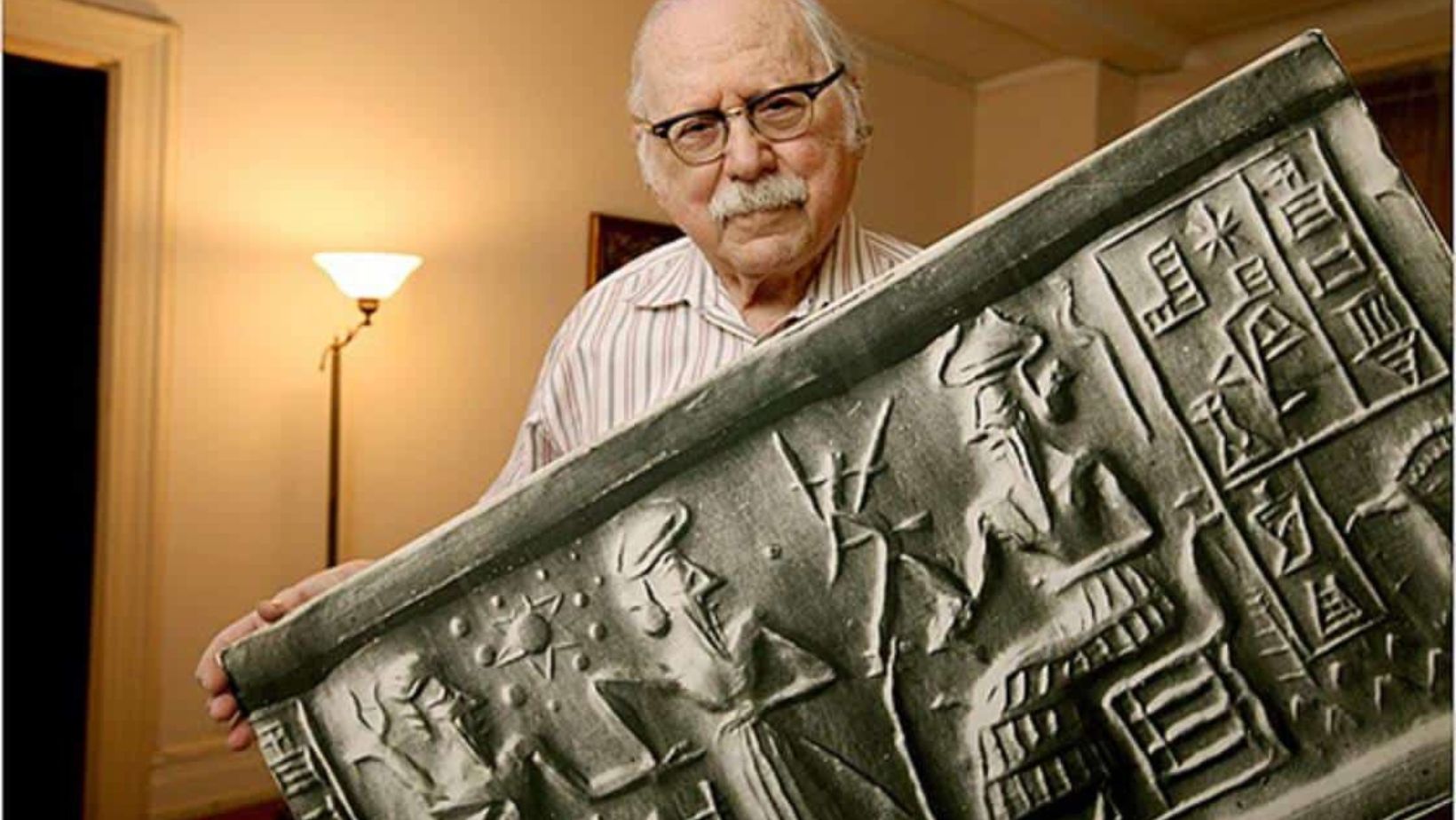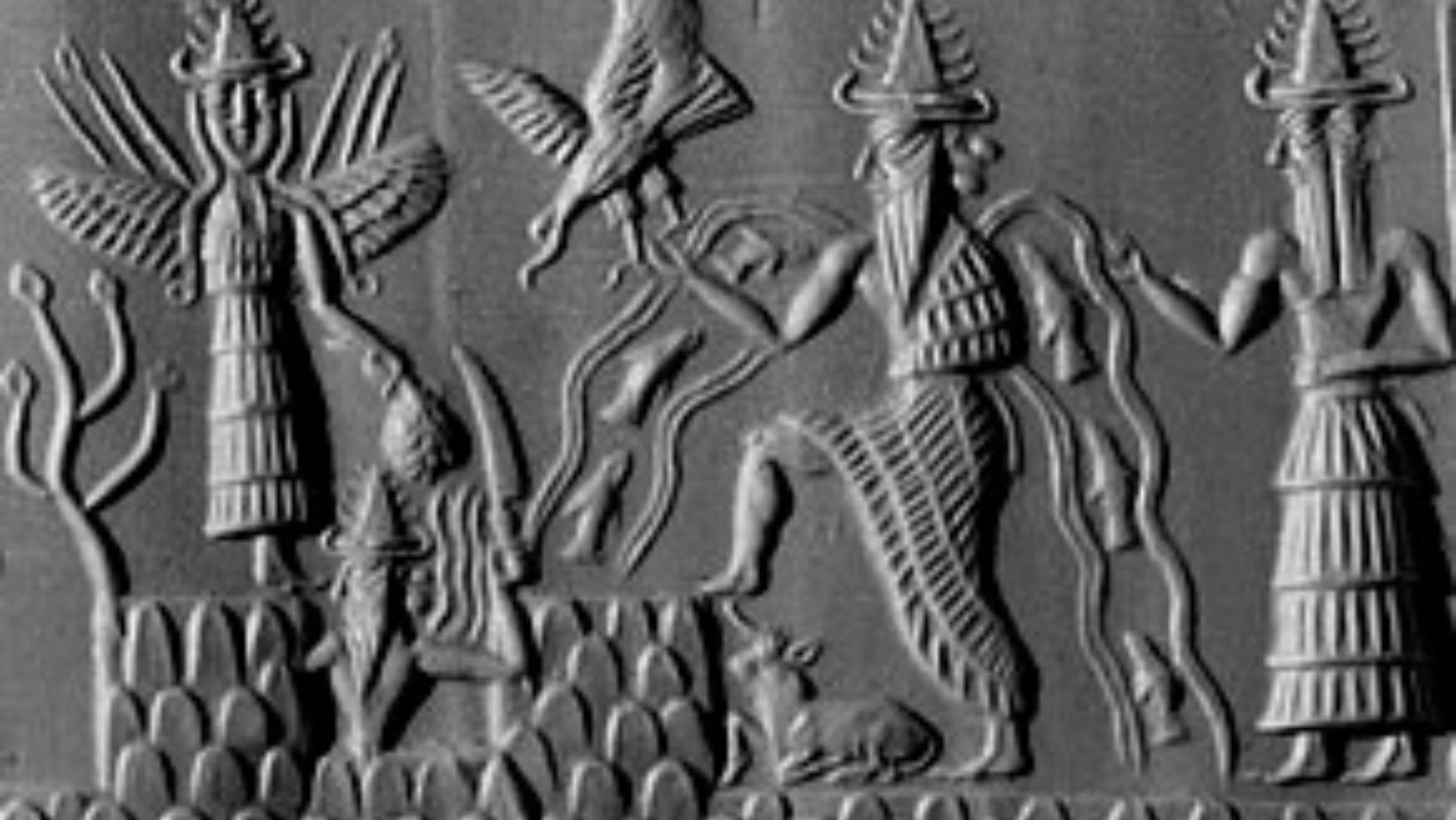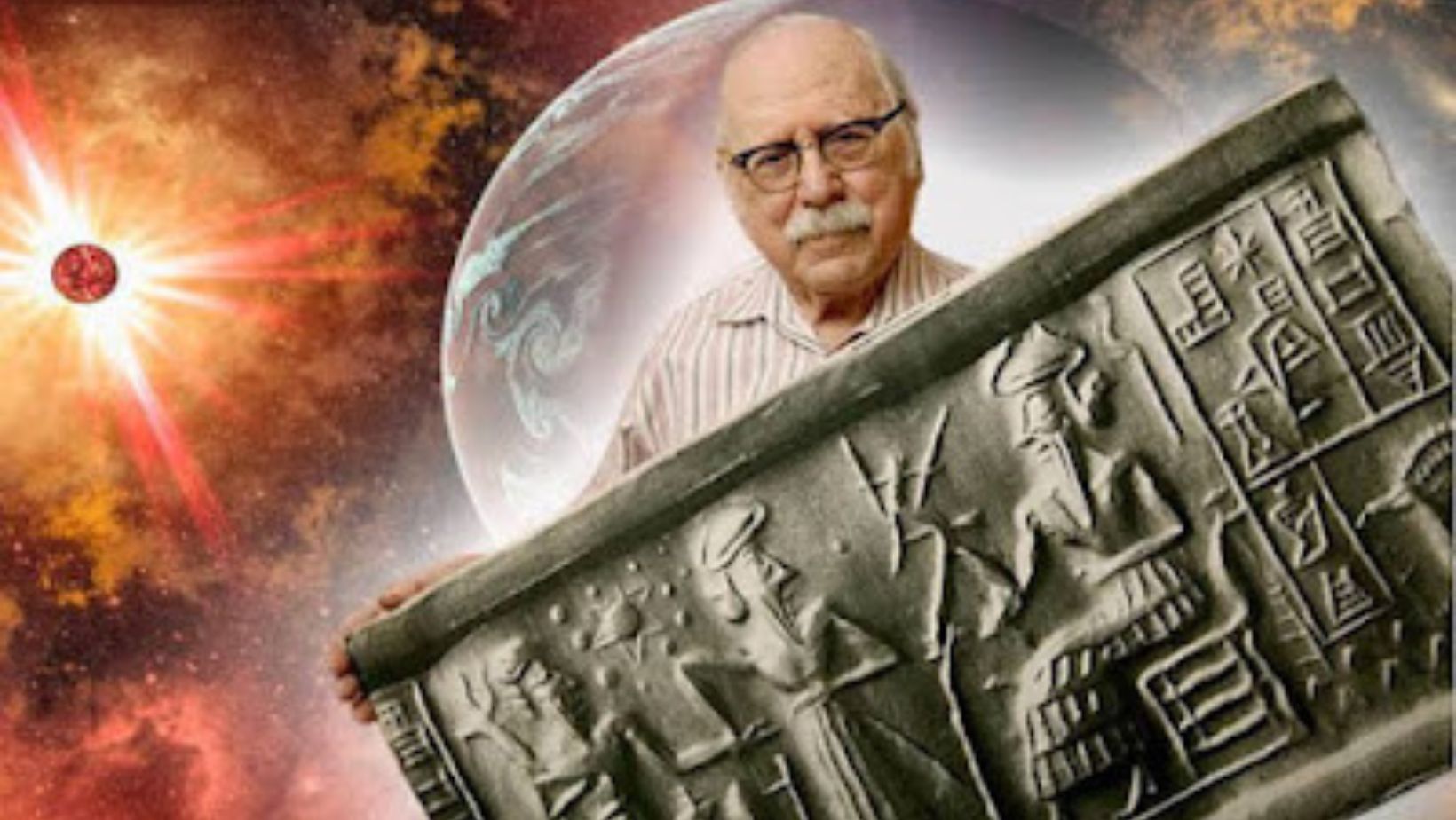Zecharia Sitchin was a controversial figure in the field of ancient history. He gained fame for his bold theories about ancient astronauts and their influence on human civilization. Sitchin argued that Sumerian texts, particularly those about the Anunnaki, reveal a hidden history of our planet. These texts, written thousands of years ago, offer insights into the beliefs and knowledge of one of the world’s earliest civilizations. Understanding Sitchin’s interpretations—and the mistranslations that shaped them—can open a fascinating window into our past. Join us as we explore the mysteries of Sumerian writings and their role in Sitchin’s groundbreaking theories.
Who Was Zecharia Sitchin?

Zecharia Sitchin was an Azerbaijani-born American author and researcher, best known for his theories about ancient civilizations and extraterrestrial influence. Born on July 11, 1920, in Baku, he later moved to Palestine and studied at the University of London. His interest in ancient languages and cultures led him to become a prominent figure in alternative history.
Sitchin is most famous for his series of books called The Earth Chronicles, which began with The 12th Planet in 1976. In these works, he proposed that the Sumerian texts describe ancient astronauts, the Anunnaki, who visited Earth and influenced humanity. He argued that these beings came from a hypothetical planet beyond Neptune, which he called Nibiru.
Sitchin’s contributions sparked significant interest in ancient astronaut theories, blending archaeology, mythology, and astronomy. His ideas, however, faced criticism from mainstream scholars for their lack of rigorous evidence and misinterpretations of Sumerian texts. Despite the controversy, Sitchin’s work continues to inspire enthusiasts and researchers interested in exploring humanity’s ancient past.
The Genesis of Zecharia Sitchin Theories
The genesis of Zecharia Sitchin’s theories began with his interpretation of ancient texts and artifacts. He focused primarily on Sumerian writings, believing they contained accounts of extraterrestrial beings. Sitchin argued that these texts revealed a history of interactions between humans and advanced beings from another planet. His ideas took shape as he connected various myths and legends from different cultures, suggesting a universal narrative about ancient astronauts.
Sitchin introduced the concept of ancient astronauts, positing that extraterrestrials visited Earth in antiquity. He claimed that these beings, known as the Anunnaki, came from a distant planet called Nibiru. According to Sitchin, the Anunnaki genetically engineered humans as a labor force for mining gold and other resources. This idea gained traction among those who seek to explain humanity’s rapid advancement in knowledge and technology.
Sitchin’s theories resonated with many who felt traditional historical narratives were insufficient. They sparked a broader interest in the possibility that extraterrestrial life played a significant role in shaping human history. While his ideas remain controversial, they have undoubtedly influenced discussions about our past and the mysteries of ancient civilizations.
Understanding Sumerian Texts: Zecharia Sitchin
Sumerian civilization, one of the world’s oldest, emerged in Mesopotamia around 4500 BCE. This remarkable culture is known for its innovations in writing, architecture, and governance. The Sumerians developed cuneiform, a writing system that used wedge-shaped marks on clay tablets. This script was primarily used for record-keeping, administrative purposes, and literary works.
Cuneiform texts are crucial for understanding the history and culture of ancient Mesopotamia. They provide insights into daily life, religious beliefs, and societal structure. Many texts contain myths, epic poetry, and legal codes that reveal the complexities of Sumerian society. These writings serve as primary sources for historians, archaeologists, and linguists seeking to piece together the past.
The study of cuneiform texts has shed light on significant developments, such as the invention of the wheel and the establishment of city-states. Sumerians also made advancements in mathematics and astronomy, evidenced by their records. As scholars continue to decode these ancient writings, they uncover the rich tapestry of human history. The Sumerian texts remain invaluable for understanding how ancient civilizations laid the foundations for modern society.
Mistranslations in Context: Zecharia Sitchin
Mistranslations of Sumerian texts have significantly impacted our understanding of ancient civilizations. One common example is the misinterpretation of the term “Anunnaki.” While Sitchin translated it as “those who came down from the heavens,” scholars argue it simply means “the royal ones.” This mistranslation sets the foundation for Sitchin’s theories about ancient astronauts.
Another notable mistranslation involves the Sumerian word “Nibiru.” Sitchin claimed it referred to a distant planet visited by the Anunnaki. However, many scholars suggest that it originally denoted a celestial body, like a star or planet, without extraterrestrial implications. This misunderstanding alters the context of Sitchin’s narrative, making it seem more plausible than it may be based on actual Sumerian beliefs.
These mistranslations have led to widespread debate among historians and linguists. Sitchin’s theories, grounded in these misinterpretations, have faced criticism from the academic community. As a result, his conclusions about ancient astronauts and their influence on humanity are viewed as speculative rather than fact-based. Understanding these mistranslations is crucial for anyone interested in the true meaning of Sumerian texts and their historical context.
Sitchin’s Interpretations of Key Sumerian Myths

Zecharia Sitchin offered unique interpretations of key Sumerian myths, particularly regarding creation stories and the pantheon of gods. He proposed that these myths describe the Anunnaki as extraterrestrial beings who created humanity for labor. According to Sitchin, the Sumerian creation myth indicates that the Anunnaki genetically engineered humans to mine gold and serve their needs. This perspective deviates significantly from traditional scholarly interpretations.
Traditional scholars view Sumerian creation myths as symbolic narratives reflecting humanity’s relationship with the divine. They emphasize themes of fertility, chaos, and the natural order rather than extraterrestrial involvement. For example, the Enuma Elish, a Babylonian creation epic, portrays gods battling for supremacy without invoking alien influences. This interpretation focuses on the sociocultural context of the Sumerians rather than an alien origin story.
Sitchin’s readings tend to sensationalize ancient texts, linking them to modern concepts of extraterrestrial life. This approach has attracted a following but also generated skepticism among historians. By comparing Sitchin’s interpretations with traditional scholarly views, we can better appreciate the complexity and richness of Sumerian mythology. Understanding these different perspectives highlights the importance of context in interpreting ancient narratives.
Criticism from Academia: Zecharia Sitchin
Zecharia Sitchin’s theories have faced significant criticism from academia. Scholars argue that his interpretations of Sumerian texts are often based on mistranslations and a lack of linguistic rigor. For instance, many linguists highlight that Sitchin’s translations of terms like “Anunnaki” and “Nibiru” do not align with established meanings in the Sumerian language. Critics contend that Sitchin’s reliance on speculative connections between ancient texts and modern concepts undermines his credibility.
In contrast, historians and linguists offer alternative interpretations grounded in a better understanding of Sumerian culture and language. They emphasize that Sumerian myths reflect the civilization’s religious beliefs and social structures rather than extraterrestrial encounters. Scholars often point to the context of creation myths as a reflection of humanity’s origins and their relationship with the divine.
Additionally, many researchers stress the importance of viewing ancient texts through an anthropological lens. This perspective helps to uncover the social, political, and environmental factors that shaped Sumerian narratives. Overall, while Sitchin’s ideas may captivate some, academic criticism calls for a more nuanced and evidence-based understanding of Sumerian civilization.
The Anunnaki and Their Role in Sitchin’s Theories
The Anunnaki are central figures in Sumerian mythology, often depicted as deities associated with the earth and sky. In traditional interpretations, they are viewed as powerful gods who governed various aspects of the natural world and human society. The Anunnaki were believed to have descended from the heavens and played significant roles in creation myths and the administration of the cosmos.
Zecharia Sitchin reinterpreted the Anunnaki in a unique way. He proposed that they were not merely gods but extraterrestrial beings who visited Earth from a planet beyond Neptune, which he referred to as Nibiru. According to Sitchin, the Anunnaki genetically engineered humans to serve as laborers in their gold mines. This radical reinterpretation suggests that ancient Sumerian texts describe interactions with advanced alien civilizations rather than mythological deities.
Sitchin’s theories connect ancient mythology to modern concepts of ancient astronauts. He claimed that the Anunnaki’s return to Earth would have profound implications for humanity. This perspective has garnered both interest and skepticism, as it challenges traditional views on the significance of the Anunnaki in Sumerian culture.
Zecharia Sitchin Legacy and Influence

Zecharia Sitchin’s theories have significantly impacted popular culture, igniting fascination with ancient astronaut concepts. His books, particularly “The 12th Planet,” introduced ideas about extraterrestrial influences on human civilization. This sparked interest in alternative histories and interpretations of ancient texts, appealing to a broad audience.
Sitchin’s work has inspired numerous documentaries, television shows, and films, embedding the idea of ancient astronauts in popular media. His theories have become a foundation for various conspiracy theories and speculative discussions about humanity’s origins. This influence is evident in the ongoing popularity of ancient astronaut theories, which continue to attract a devoted following.
Moreover, the blending of history and science fiction has created a unique niche in which many explore the possibilities of extraterrestrial life and its impact on ancient cultures. Events like conferences and online communities thrive on discussions of Sitchin’s ideas and similar theories. This indicates a persistent curiosity about our past and the potential for connections beyond Earth.
Overall, Sitchin’s legacy endures, as his ideas continue to challenge conventional narratives and inspire new inquiries into the mysteries of ancient civilizations.
Decoding the Mistranslations: A Critical Approach
Decoding mistranslations of Sumerian texts requires a critical and methodical approach. First, scholars must engage in a thorough linguistic analysis, examining the nuances of the cuneiform writing system. This includes understanding the context in which words were used, as meanings can shift depending on the surrounding text. Cross-referencing various sources can also help clarify ambiguous translations.
Interdisciplinary collaboration plays a crucial role in accurately interpreting ancient texts. Historians, linguists, archaeologists, and anthropologists can offer diverse perspectives, enhancing our understanding of Sumerian culture and language. Combining expertise from different fields allows for a more comprehensive analysis of the texts, leading to more accurate translations.
Additionally, using advanced technology, such as digital imaging and computational linguistics, can aid in deciphering cuneiform inscriptions. These tools can reveal patterns and details that might be overlooked in traditional analyses. A collaborative approach fosters a richer understanding of Sumerian texts and helps rectify previous mistranslations. By encouraging dialogue among specialists, we can ensure a more nuanced interpretation of ancient writings, contributing to the broader understanding of human history.
Conclusion: Zecharia Sitchin
In conclusion, accurate translations of ancient texts are vital for understanding our shared history. Mistranslations can lead to misconceptions, as seen in the interpretations of Zecharia Sitchin. By critically analyzing Sumerian texts and considering various scholarly perspectives, we can gain a clearer picture of the civilization’s achievements and beliefs. Exploring Sumerian culture beyond Sitchin’s theories opens up new avenues for understanding the complexities of human history. Let us encourage further research and appreciation of the rich legacy of Sumerian civilization, fostering a deeper connection to our ancient past.
FAQs
What motivated Zecharia Sitchin to write about Sumerian texts?
Sitchin was driven by a fascination with ancient civilizations and their myths. He sought to explore the idea that advanced beings influenced human history, particularly through the Sumerian texts. His passion for archaeology and history fueled his theories, leading him to present a unique interpretation of ancient writings.
How have Sitchin’s theories influenced modern conspiracy theories?
Sitchin’s ideas about ancient astronauts and extraterrestrial beings have inspired numerous conspiracy theories. His interpretations suggest that aliens visited Earth and played a role in human evolution, which has resonated with many in popular culture. This has led to a broader interest in alternative history and fringe theories.
What are some major criticisms of Sitchin’s methodology?
Critics often point to Sitchin’s selective use of evidence and his lack of linguistic training as major flaws. Many scholars argue that he misinterpreted key terms and symbols in Sumerian texts. Additionally, his reliance on speculative connections has been deemed insufficient in rigorous academic standards.
Are there any reputable scholars who support Sitchin’s theories?
While Sitchin has garnered a following among enthusiasts, he lacks significant support from the academic community. Most reputable scholars reject his interpretations due to methodological flaws and a lack of credible evidence. The consensus among experts is that his theories do not hold up under scrutiny.
What resources can I explore for a more accurate understanding of Sumerian civilization?
For a deeper understanding of Sumerian civilization, consider exploring works by established scholars in the field. Books by authors like Samuel Noah Kramer and Jeremy Black provide insights into Sumerian history, culture, and language. Academic journals and online courses focusing on ancient Near Eastern studies are also valuable resources.

